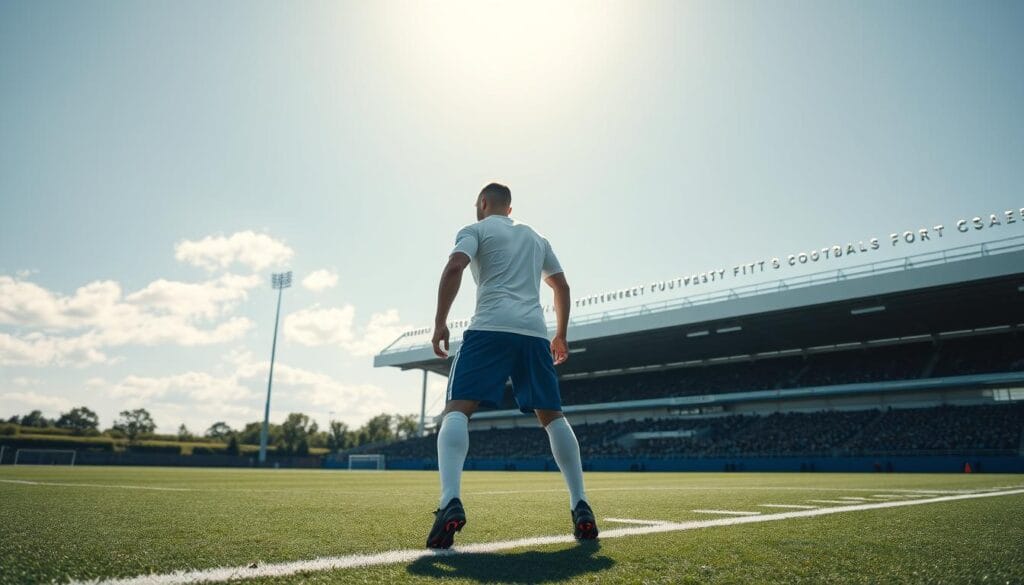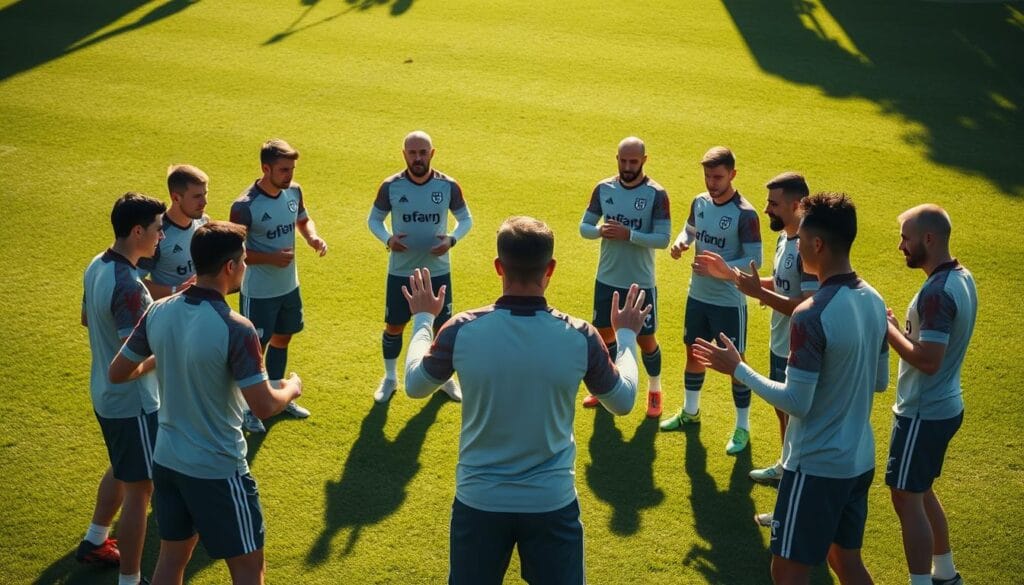How to Play as a Centre-Back in Football
Playing as a center-back in football is all about discipline, awareness, and making quick decisions. Your main job is to keep your team’s goal safe by stopping the other team’s attackers. You must read the game, tackle wisely, and team up with other defenders to form a strong defense.
This role is crucial for both defending and starting attacks from the back. It’s a key position in football.

Being strong and fast helps you win battles for the ball. You also need to stay focused to track opponents and know when to clear the ball or pass it out of defense. Every action you take can affect your team’s success, so it’s important to get these basics right.
Key Takeaways
- A center-back’s main job is to stop opponents from scoring by blocking passes and tackling.
- Successful play requires balancing aggression with smart positioning to avoid risky challenges.
- Communication with teammates keeps the defensive line organized and prevents gaps.
- Physical fitness and stamina are critical to maintain high intensity across 90 minutes.
- Quick decisions on passes or clearances prevent turnovers and keep control of the game.
Table of Contents
Understanding the Centre-Back Position
Being a center-back requires sharp focus and quick thinking. This role is crucial for any team’s defense. Let’s explore what makes it special:
Key Responsibilities of a Center-Back
- Mark opposing strikers to disrupt their scoring chances
- Clear crosses and aerial balls from dangerous areas
- Make timely tackles without committing fouls
- Start attacks by passing to teammates under pressure
Differences Between Center-Back and Other Defensive Positions
Center-backs stay in the middle, unlike fullbacks who move wide. Defensive midfielders aim to intercept passes. But center-backs focus on direct marking.
Fullbacks cover the sides, while center-backs anchor the defense in set pieces and open play.
The Importance of Center-Backs in Modern Football
Today’s center-backs must do more than just tackle. Coaches want them to:
- Read plays 10-15 seconds before they happen
- Execute 60+ pass accuracy in build-up phases
- Combine speed and strength to handle modern strikers
Teams like Manchester City’s John Stones show the modern center-back’s role. They balance defense and attack well. Your skill in moving between defense and attack is key to team success.
Essential Defensive Skills for Center-Backs
Learning the basics of the centre-back role is key. We’ll cover drills and tips to enhance your defensive game.

- Tackling: Practice standing tackles with your body low. Slide tackles are best when you’re at an angle, not straight on. Always put safety first.
- Heading: Meet crosses and aerials with your body sideways. Time your jumps well to win the ball cleanly. Use your forehead, not the top of your head.
- Intercepting: Anticipate passes by watching the attackers. Place yourself between the ball and the goal, cutting off passing lanes early.
- Blocking shots: Stay between the shot and the goal. Bend your knees and extend your arms to deflect shots without diving.
- Jockeying: Keep 10-15 yards from attackers in 1v1s. Use side steps and backward movements to force them wide, never retreating straight back.
Work on strength with squats and lunges. Sprints and ladder drills improve your speed and agility. Add partner drills like shadow defending, tackling dummies, and heading practice against a wall.
Every decision is crucial. Stay patient, read the play early, and trust your instincts. These skills make you a dependable how to play as center back player.
Mastering Positioning and Spatial Awareness
Being in the right place is key for a centre-back. To play well as a center back, learn these spatial tactics. They help you control the game:
Maintaining Proper Defensive Shape
Keep your defensive line in order with these tips:
| Defensive Line Type | When to Use | Pros/Cons |
|---|---|---|
| High Line | Against slower teams | Riskier but limits passing lanes |
| Medium Line | Standard play | Balance between risk and safety |
| Low Line | Protecting leads | Solid but allows opponent possession |
When to Step Up vs. Drop Back
- Step up: Close fast attackers early to disrupt their speed
- Drop back: Retreat if opponent uses through balls or has a long passer
- Always stay 10-15 yards from your partner to avoid gaps
Covering for Defensive Partners
Keep an eye on your teammates:
- Shift sideways when fullbacks push forward
- Communicate loudly to mark overlapping wingers
- Overlap with your partner to close crossers
Dealing with Different Attackers
| Attacker Type | Defensive Response |
|---|---|
| Speedsters | Stay compact; avoid chasing |
| Physical Strikers | Use your body to block passes |
| Technical Playmakers | Stay 3-5 yards back to counter dribbles |
Communication and Leadership as a Center-Back
As a center-back, your voice is key. It turns chaos into control. Simple phrases like “Cover!” or “Step up!” help guide your team and close gaps. Leadership is about being clear, not complicated.

Direct Your Line with Precision
Use short, loud commands to keep your defenders in line:
- “Back line, narrow!” to close passing lanes
- “Pressure the ball!” to force turnovers
- “Mark the runner!” to assign defensive duties
Sync with Your Goalkeeper
Call out threats early. Shout “Cross incoming!” to signal positioning. Agree on roles: you cover near post duties while the keeper handles the far post. During through balls, yell “I’m on the striker!” to avoid collisions.
Lead During Set Pieces
At corners, assign markers with “Take the near post man!” and confirm coverage zones. On free kicks, bark “Drop deep!” to adjust defensive shape. Your commands create order where there’s pressure.
Practice communication drills every day. Work with a teammate: one acts as an attacker while you call out commands. Leadership isn’t just about tackles—it’s about turning urgency into unity. Your voice is the shield your team relies on.
Conclusion: Becoming an Elite Center-Back
To master center back, you need discipline, adaptability, and a deep game understanding. Elite defenders like Virgil van Dijk and Éder Militão are great examples. They mix physical strength with smart tactics.
Start by practicing the basics: intercepting passes and keeping a defensive shape. Watch how top players handle 1v1 duels and high-pressing forwards. Use drills that mimic real games, like reacting to through balls.
Remember, becoming a top defender takes time. Many reach their peak in their late 20s. Work with goalkeepers to improve teamwork. Your unique strengths will shape your playing style.
Keep track of your progress by recording training. Look for coaches who focus on making smart decisions under pressure. The best defenders react quickly and make smart choices. With hard work and learning from mistakes, you can excel in this key role.
FAQ
What are the key responsibilities of a centre-back?
A centre-back’s main job is to mark opposing strikers and block shots. They also win aerial duels, make crucial tackles, and help with the team’s build-up play. It’s important to stay aware of your position and keep a solid defensive shape to protect your goal.
How does playing as a centre-back differ from other defensive positions?
Centre-backs focus mainly on defence, unlike full-backs who support attacks. Defensive midfielders help shield the defence, but centre-backs face attackers head-on and deal with threats in the penalty area.
What physical attributes should a successful centre-back possess?
A good centre-back needs strength, agility, and speed. Strength helps in holding off attackers. Agility and speed are key for reacting to opponents and moving from defence to attack.
How important is communication for a centre-back?
Communication is crucial for a centre-back. They must organize the defensive line, give instructions to teammates, and work with the goalkeeper. Clear commands help avoid confusion and keep the team’s defence in shape.
What techniques should I focus on to improve my tackling?
Work on different tackling techniques like standing and slide tackles. Always assess the situation and choose the right moment to tackle. This helps avoid fouls and keeps your defensive position strong.
How can I enhance my aerial ability as a centre-back?
To improve your heading, practice timing your jumps and positioning. Use both attacking and defensive headers. Regular drills will boost your confidence in dealing with high balls.
What should I do when an attacker cuts inside?
When an attacker cuts inside, keep your body positioned right and be ready to intercept. Use jockeying to stay balanced and react quickly. This also puts pressure on the attacker to make a poor choice.
How can I support my team’s build-up play as a centre-back?
To support build-up play, make accurate short passes to midfielders. Provide options for teammates and know when to step into midfield. Being comfortable with the ball at your feet helps the team’s play.
What strategies are useful for handling different types of attackers?
Adapt your strategy based on the attacker’s type. For fast players, focus on intercepting passes. For stronger attackers, use your body to win aerial battles and prevent them from turning.